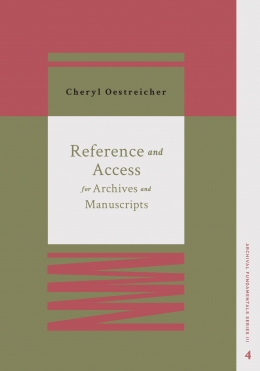
Primary tabs
You don't need to be an ALA Member to purchase from the ALA Store, but you'll be asked to create an online account/profile during the checkout to proceed. This Web Account is for both Members and non-Members.
If you are Tax-Exempt, please verify that your account is currently set up as exempt before placing your order, as our new fulfillment center will need current documentation. Learn how to verify here.
- Description
- Table of Contents
- About the author
- Reviews
SAA’s 2021-2023 One Book, One Profession Selection
Access and reference services are central to engaging with historical resources. As more people encounter archives for scholarly and avocational research, as part of creative pursuits, or to exercise their rights as citizens to access records, the possibilities for how collections are used will continue to evolve. Archivists need to be familiar with who their users are, understand why they’re using archival collections, and engage in outreach so that they can provide excellent reference services. Reference and Access for Archives and Manuscripts outlines the various components of
- providing physical, intellectual, and virtual access;
- acquiring reference knowledge and skills;
- navigating legal regulations and ethics; and
- designing use policies and effective outreach.
Cheryl Oestreicher contextualizes how all of these components fit within other archival functions and offers strategies and detailed practices for creating comprehensive reference programs that archivists can adapt for any type of institution. Both new and experienced archivists will find Reference and Access for Archives and Manuscripts a solid foundation on which to add their own ideas for how to bring people into the archives as well as bring archives to the people. Readers are encouraged to examine these concepts and practices in conversation with others and to consider how archivists can continue to advance reference and access.
Examination copies are available for instructors who are interested in adopting this title for course use.
The Evolution of a Book Series
Preface
Introduction
Reference and Access: Historical Influences and Innovations
Conclusion
1. Contextualizing Reference Within an Archives Program
Acquisition and Appraisal
Arrangement and Description
Digital Content
Outreach and Advocacy
Conclusion
2. Reference Skills and Knowledge
Knowledge
Technical Skills and Knowledge
Interpersonal Skills
Reference Manual
Training
Conclusion
3. Users
Information Seeking
Archival Literacy and Intelligence
User Types
Conclusion
4. Reference Interaction
Behavior and Communication
Reference Interview
Virtual and Remote Reference
Dealing with Difficult Patrons
Conclusion
5. Physical Access
Reading Room and Research Area
Staffing
Registration
Use and Handling
Security
Conclusion
6. Intellectual Access
Arrangement and Description
Access Outputs
Conclusion
7. Virtual Access
Websites
Digital Collections
Systems and Formats
Metadata
Virtual Reading Room
Innovations in Digital Research
Conclusion
8. Ethics, Patron Privacy, and Accessibility
Ethics
Patron Privacy
Accessibility
Conclusion
9. Legal Regulations
Freedom of Information Act
Family Educational Rights and Privacy Act (FERPA)
Privacy Act
Copyright
Restrictions
Conclusion
10. Use Policies
Types of Uses
Reproductions
Copyright and Public Domain
Procedures
Loans
Attributions
Conclusion
11. Outreach
Development and Strategy
Social Media
Crowdsourcing
Friends Groups
12. Assessment of Reference Programs
Public Services Metrics
User Studies
Data Ethics and Privacy
Conclusion
13. The Future of Access and Reference
Postscript
- Appendix A: Examples of Reference Manuals
- Appendix B: Examples of Registration Forms
- Appendix C: Examples of Online Reference Request Forms
- Appendix D: Examples of Access Outputs, Alternative Formats
- Appendix E: Examples of Reproduction Request Forms
- Appendix F: Examples of Permission to Publish Forms
Bibliography
About the Author
Index
Cheryl Oestreicher
Cheryl Oestreicher is the head of Special Collections and Archives and associate professor at Boise State University. She has a PhD in modern history and literature from Drew University and an MLIS from Dominican University. She previously worked at Auburn Avenue Research Library on African American Culture and History at Emory University, the University of Chicago, Drew University, and Princeton University. Oestreicher has taught introduction to archives, archives management, reference, and research methods at Georgia State University, Clayton State University, and Boise State University. She has been actively involved in SAA by serving on the Publications Board, Manuscripts Section Steering Committee, 2016 Annual Meeting Program as co-chair, and the SAA-ACRL/RBMS Joint Task Force to Revise Statement on Access. She was the 2015 recipient of the Emerging Leaders Award. For the Academy of Certified archivists, she was a member of the Recertification Review Task Force and Nominating Committee, and serves on the Exam Development Committee focusing on Domain 3: Reference Services and Access. She has served as a grant reviewer for the Council on Library and Information Resources, National Historical Publications and Records Commission, and the National Endowment for the Humanities. She is a former editor of Provenance, the journal of the Society of Georgia Archivists.
"For students of archival studies, this work is an excellent tool for understanding what reference archivists do, how such departments function, and how they fit within the larger picture of an archival organization. This volume would be particularly helpful as archival course material, as well as for archivists who are new to the reference side of archival work. A great strength of the book is that concepts are presented in a way that encourages readers to apply them to their own organizations."
—Kayla Scott, American Archivist


